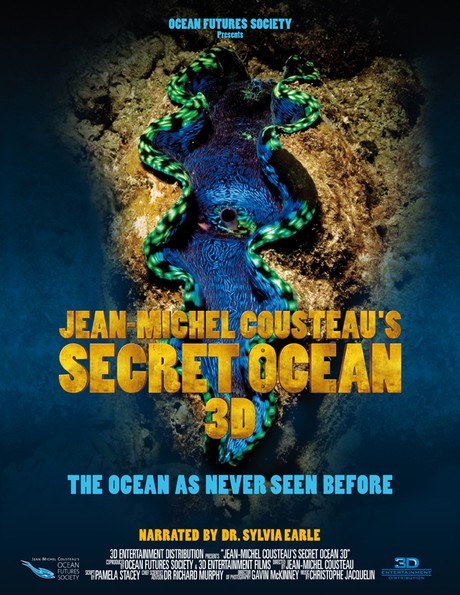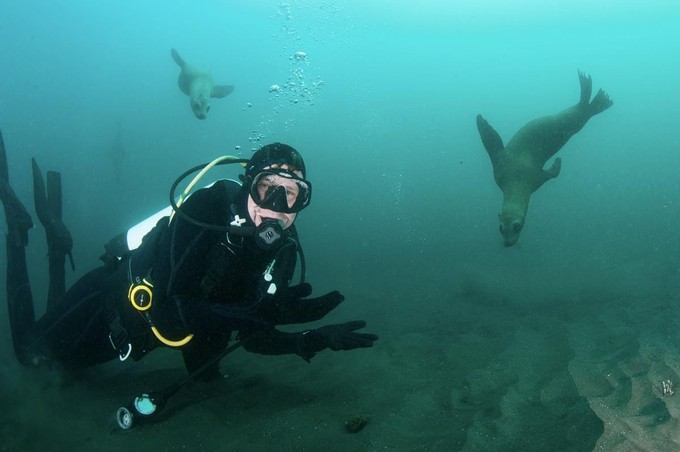The 2015 Santa Barbara International Film Festival is underway — a veritable orgy of celebrities, cinema, and parties. It is best known locally for drawing massive stars for long sit-down interviews in the 2200-seat Arlington theater including the likes of DiCaprio, Scorsese, Cameron, and Oprah, to name a few. Those are great, but my favorite moments are when the realms of science, activism, and moviemaking collide, and the people who are making a real difference in the world are celebrated right alongside those gracing the gossip magazines. Such was the case Wednesday night when the Cousteau family were given the Attenborough Award, premiered their new film SECRET OCEAN 3D, and sat down for a long chat about the wonders of the sea and the importance of protecting the Earth’s oceans.

Thanks to its beachside location, SBIFF has always paid special attention to water-related films, whether it is surf movies or ocean documentaries. For example, last year the opening night film was the Sylvia Earle doc MISSION: BLUE. This heritage is due in no small part to marine biologist, explorer, TV personality, and TED fellow Mike deGruy. Mike brought his enthusiasm to SBIFF, presenting some of his favorite ocean-related films and often interviewing the filmmakers. Sadly, he died in a helicopter crash in 2012. Still, his impact has been long-lasting, and his widow, Mimi deGruy remains involved with the festival. She suggested the Cousteau family for the award and presented it, along with a video introduction from Sir David Attenborough himself.
While those of us of a certain age grew up watching Jacques Cousteau’s adventures on TV, younger readers may only know him as the real-life Steve Zissou. So first a little background: Jacques Cousteau is the co-inventor of the demand valve, aka regulator, aka that thing you breathe through, which made modern Scuba diving possible. He was an amazing scientist, inventor, author, activist, explorer, and filmmaker. Over decades, he, the crew of the Calypso, and sometimes his family traveled the globe, researching, documenting, and educating the public about the world’s oceans. After Jacques Cousteau’s death, his son Jean-Michel (now 76) has carried on his legacy, as have Jean-Michel’s children Fabien and Céline. Jean-Michel has produced dozens of films, has won countless awards, and founded the nonprofit Ocean Futures Society.
Before the interview, they premiered Jean-Michel’s latest film, SECRET OCEAN 3D. We saw the “normal” 3D version, but it will be released in various IMAX formats as well. It was shot over 3 years in a variety of locations, including the Bahamas and Fiji. They even developed new technology to shoot it, allowing never-before-possible close-ups, slow motion, and motion-control shots. The results are stunning. In some ways it is better than being there. You don’t have to shiver in a setsuit, fiddle with equipment, or do the hundreds of dives necessary to catch the perfect moments that illustrate the lives of an exotic array of sea creatures. And using this technology, tiny inch-long creatures are blown up to 40-foot movie size.
I’ve done plenty of diving myself, and I’ve even shot some scenes underwater for the TV show UNIVERSE on the History Channel (that episode should show up in the spring).

I can tell you from experience that it is ridiculously hard to shoot and light scenes underwater. First, neither the director, talent, or camera operator can easily communicate with each other (those full-face masks don’t transmit to each other). Then getting the lighting and focus just right requires a hell of a lot of patience and experimentation. Sea creatures rarely want to cooperate and swim in front of your camera at just the right time. And 3D filming adds a whole world of insanity on top of that. To top it off, you can’t shoot for long before you have to surface, change batteries, air tanks, or worse in the case of IMAX — film! Each cycle of surfacing and resubmerging can take quite a while, and you can only do so many dives in a day before you have to let the nitrogen outgas from your tissues. So even though SECRET OCEAN 3D is only about 40 minutes long, each minute took days to film. But the results are astounding.
We’ve seen plenty of large animals in ocean documentaries before, and there are a few here — an octopus, manta ray, and hermit crab to name a few. But the new camera setup has also allowed for shots we’ve rarely seen, like a tiny goby nestled in a hole, or a time lapse of a basket star unfolding as it prepares for nocturnal feeding. In fact there are creatures shown that I’ve never even heard of, much less seen on film.
The focus of SECRET OCEAN is on the food chain. It starts with plankton, which is then gobbled up by the likes of tube worms, basket stars, and manta rays. Larger fish then eat the smaller ones. Life in the sea is all about eating and not being eaten. One theme is the lengths different creatures go to to avoid becoming a meal: herding, camouflage, hiding, armor, poison, symbiotic relationships with a protector, and even tasting bad. They were able to capture some truly spectacular examples: a conch flipping itself over, an octopus morphing in shape and color like some kind of space alien, the nasty-tasting sea cucumber, and a whirlwind of squid.
Concentrating on the food chain underscores the fact that the ocean is an ecosystem, and one in delicate balance. The filmmakers also highlight some of the things we are doing to screw it up: polluting it, warming it, overfishing, and introducing invasive species. But that doesn’t overwhelm the overarching narrative of wonder at the largely unseen, mysterious, and alien environment below the surface.
SECRET OCEAN was narrated by one of the foremost ocean explorers and conservationist, Sylvia Earle. This is a great choice — she’s an expert, and the brings a welcome combination of gravitas, wisdom, and enthusiasm. I was slightly less enthusiastic about the conceit of having Jean-Michel Cousteau and biologist Holly Lohuis are narrating some of the bridging material while diving. It makes it seem that everything in the film was shot in one dive, when the truth is more compelling. When they are in the shots with a fascinating animal it works well. But it was all too clear to me that they looped their dialog after shooting, and you can tell that what they are pointing out wasn’t necessarily shot at the same time as the close-up. While it is common practice to record audio after the fact (I did it), they don’t even try very hard here to make it seem natural. I’d have preferred to see them talking on the surface after a dive and see the enthusiasm in their faces expressing the rush you get when you’ve experienced something new or rare. In the masks you can’t tell anything about their personalities — they could be anyone.
But that’s just a nitpick, and something I’m probably in the extreme minority on, since I know how the sausage is made. The real message is that SECRET OCEAN is a must-see not just for ocean fans, but for everyone on the planet. Hell, why stop there, if there are aliens out there, they should see it too. It is a great way to show off the profound things evolution has done with the Earth as the raw material. It is the culmination of years of diving knowledge and technology. And it is a great combination of science and artistry. We live in amazing times. Take advantage of it.
Secret Ocean 3D - A film by Jean-Michel Cousteau - Teaser from 3D Entertainment Distribution on Vimeo.
- Copernicus (aka Andy Howell). Email me or follow me on Twitter.
